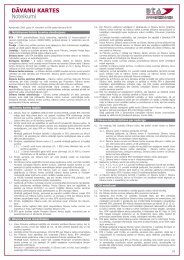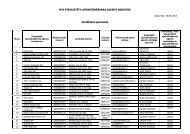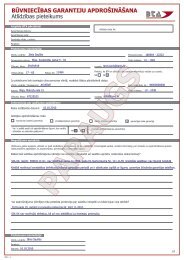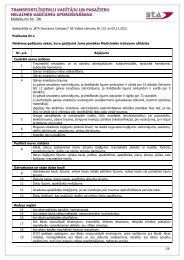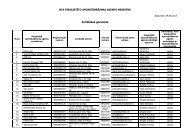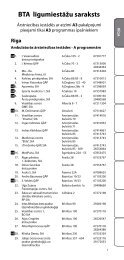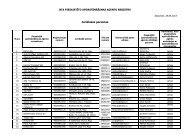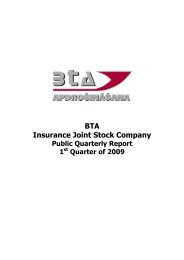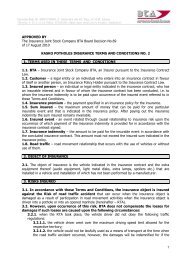BTA Insurance Joint Stock Company Public Quarterly Report 4 ...
BTA Insurance Joint Stock Company Public Quarterly Report 4 ...
BTA Insurance Joint Stock Company Public Quarterly Report 4 ...
You also want an ePaper? Increase the reach of your titles
YUMPU automatically turns print PDFs into web optimized ePapers that Google loves.
(f) Liability Conformity Test<br />
The <strong>Company</strong> has assessed its insurance liabilities presented in the financial<br />
statement as at 31 December 2009 applying the liability conformity test (“LAT”).<br />
The liability conformity test is conducted on each financial statement date in a<br />
breakdown by types of insurance in order to evaluate whether the recognized<br />
insurance liabilities less deferred customer attraction expenses are appropriate taking<br />
into consideration future cash flow from insurance contract under current<br />
calculations. If the evaluation shows that liabilities are not appropriate taking into<br />
account future cash flow, the deficiency is recognized in the Income Statement. The<br />
expected cash flow related to insurance claims and expenses is calculated using<br />
historical data adjusted by significant particular losses, the re-occurrence of which is<br />
not expected. The liability conformity test is conducted in a breakdown by types of<br />
insurance, which include insurance contracts with similar types of risks.<br />
Financial Risks and Risk Management<br />
The <strong>Company</strong> is exposed to financial risks if it makes transactions with financial<br />
instruments. Financial risks include the market risk, which, in turn, includes price,<br />
interest rate and currency risks, the credit risk and the liquidity risk. The description<br />
and summary of financial risks regarding the methods applied by the <strong>Company</strong> in the<br />
management of these risks are provided below. These risks are caused by daily<br />
business activities of the <strong>Company</strong>.<br />
Financial assets and financial liabilities of the <strong>Company</strong>, including investments, bank<br />
deposits, loans, insurance receivables and reinsurance assets, are exposed to the<br />
following financial risks:<br />
• Market risk: negative changes in the market situation may affect the insurer’s<br />
assets and/or liabilities, investments may depreciate and return of assets may<br />
decrease; The Market risk includes interest rate risk, capital price risk and<br />
currency risk;<br />
• Credit risk: failure of the business partner to fulfil contractual obligations may<br />
cause financial losses to the <strong>Company</strong>;<br />
• Liquidity risk: under certain adverse conditions, the insurer may be forced to sell<br />
assets at a lower price than the fair value thereof to fulfil the obligations.<br />
Market Risk<br />
Financial instruments and items are exposed to the market risk, which is the risk that<br />
changes in the market situation in the future may decrease or increase the value of<br />
the financial instrument. The <strong>Company</strong> is exposed to a potential investment risk by<br />
incurring losses from financial assets, financial liabilities, reinsurance and insurance<br />
contractual obligations caused by changes in interest rates, exchange rates and<br />
prices of capital instruments.<br />
In order to hedge the investment risk, investments are made in different financial<br />
instruments. Requirements of the Law on <strong>Insurance</strong> Companies and Supervision<br />
Thereof are complied with when selecting financial instruments.<br />
When performing investment activity, employees of the AAS <strong>BTA</strong> Financial<br />
Department comply with the improved investment procedures, which regulate many<br />
issues related to the control and hedging of the investment risk.<br />
The investment risk hedging is carried out in two ways – first, by diversifying the<br />
investment portfolio and second, by analysing the asset before the purchase thereof<br />
and regularly obtaining available information on it later.<br />
The <strong>Company</strong> manages the market risk by mainly investing in markets and<br />
investments with high ratings.<br />
11



